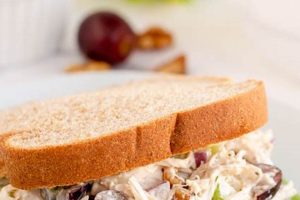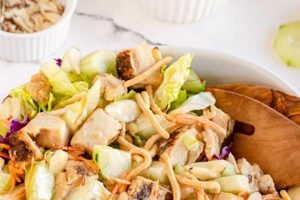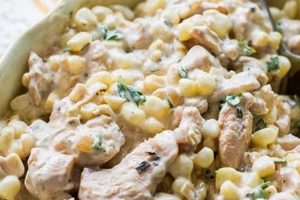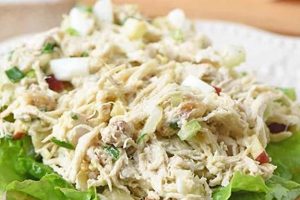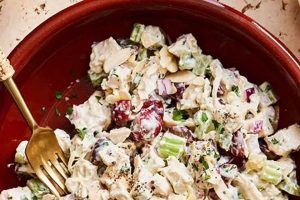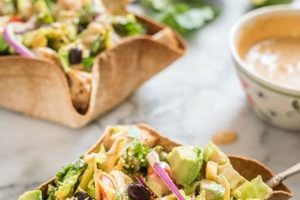A pasta salad variation inspired by the classic Cobb salad, this dish typically combines cooked pasta, chopped chicken breast, bacon, hard-boiled eggs, tomatoes, avocado, blue cheese, and a vinaigrette dressing. Variations may include different types of pasta, cheeses, or vegetables. An example might feature rotini pasta, grilled chicken, crumbled Roquefort, and cherry tomatoes, dressed with a red wine vinaigrette.
This dish offers a convenient and satisfying meal option, incorporating protein, healthy fats, and various vitamins and minerals. Its customizable nature allows for adjustments to dietary needs and preferences. As a cold salad, it is particularly well-suited for warm weather or potluck gatherings. While the Cobb salad’s origins trace back to the 1930s, pasta salad variations likely emerged later as pasta gained popularity in American cuisine.
The following sections will explore various aspects of creating this dish, including ingredient selection, preparation techniques, dressing options, and serving suggestions.
Tips for a Superior Pasta Salad
Optimizing ingredient selection and preparation techniques elevates this dish from simple to exceptional.
Tip 1: Pasta Choice Matters: Opt for shorter pasta shapes like rotini, farfalle, or penne. These hold the dressing well and provide a pleasant textural contrast to the other ingredients.
Tip 2: Perfectly Cooked Chicken: Achieve tender, flavorful chicken by grilling, baking, or poaching. Avoid overcooking, which can result in dry, stringy meat. Dice or shred the chicken to ensure even distribution throughout the salad.
Tip 3: Crisp Bacon Perfection: Baking or pan-frying bacon yields optimal crispness. Crumble it after cooking for easy incorporation and even flavor dispersion.
Tip 4: Hard-Boiled Egg Mastery: Precisely cooked hard-boiled eggs enhance both flavor and presentation. Avoid overcooking, which can create a rubbery texture and a greenish ring around the yolk.
Tip 5: Avocado Handling: Add avocado close to serving time to prevent browning. Gently toss it with the other ingredients to avoid excessive mashing.
Tip 6: Balancing Flavors: Blue cheese adds a pungent, salty note. Balance this with the acidity of the vinaigrette and the sweetness of the tomatoes. Consider milder blue cheeses like Gorgonzola for a less intense flavor profile.
Tip 7: Dressing Considerations: A classic vinaigrette complements the dish well. Customize it with herbs, spices, or different types of vinegar to enhance the overall flavor profile.
Tip 8: Chilling for Optimal Flavor: Allow the salad to chill for at least 30 minutes before serving. This allows the flavors to meld and the ingredients to absorb the dressing.
By following these tips, one can create a balanced and flavorful pasta salad experience.
These techniques offer a foundation for culinary success with this versatile dish.
1. Ingredients
Ingredient selection significantly impacts the final quality and flavor profile of a chicken Cobb pasta salad. Careful consideration of each component ensures a balanced and satisfying culinary experience. The following explores key ingredient categories and their contributions to the dish.
- Protein:
Chicken breast is the traditional protein choice, offering a lean and versatile base. Alternatives include grilled or roasted turkey, or even chickpeas for a vegetarian adaptation. The protein provides substance and satiety.
- Produce:
Fresh vegetables provide texture, color, and nutrients. Essential components include crisp romaine lettuce, ripe tomatoes, and creamy avocado. Other additions might include cucumbers, bell peppers, or red onion, enhancing the salad’s visual appeal and flavor complexity.
- Dairy and Cheese:
Blue cheese contributes a characteristic tangy and salty flavor. Feta or crumbled goat cheese offer milder alternatives. Hard-boiled eggs provide additional protein and a creamy texture. These elements bind the ingredients and contribute richness.
- Binding and Flavor Enhancement:
Bacon adds a smoky, savory element, while a well-balanced vinaigrette provides acidity and moisture, tying all the ingredients together. The vinaigrette can be customized with herbs, spices, and different types of vinegar to create unique flavor profiles. This cohesive blend of flavors distinguishes the Cobb from other salads.
The interplay of these ingredient categories creates a complex and harmonious flavor profile, crucial to a successful chicken Cobb pasta salad. Thoughtful selection and preparation of each ingredient contribute to the overall quality and enjoyment of the dish.
2. Preparation
Preparation constitutes a critical stage in creating a successful chicken Cobb pasta salad. Methodical execution of each step ensures optimal flavor development and textural balance, differentiating a well-made salad from a mediocre one. The following facets highlight key preparation procedures.
- Pasta Cooking:
Cooking pasta al dente is crucial for achieving the desired texture. Overcooked pasta becomes mushy and absorbs less dressing, while undercooked pasta remains unpleasantly firm. Following package directions and testing for doneness ensures optimal results. Rinsing the cooked pasta under cold water stops the cooking process and helps cool it down quickly, preserving texture and preventing sticking. For instance, slightly firm rotini holds its shape well when combined with other ingredients and absorbs the dressing effectively.
- Protein Handling:
Properly handling the protein component significantly influences the salad’s overall quality. Chicken, the typical choice, benefits from gentle cooking methods like poaching or grilling to maintain moisture and tenderness. Dicing or shredding the chicken into bite-sized pieces ensures even distribution throughout the salad and facilitates easier consumption. Alternatively, using pre-cooked rotisserie chicken streamlines the process.
- Ingredient Preparation:
Uniformly chopping vegetables, such as tomatoes and avocado, creates visual appeal and promotes even flavor distribution. Crisp vegetables contribute satisfying textural contrast to the softer pasta and protein. Properly dicing bacon ensures it integrates seamlessly with the other ingredients. Hard-boiled eggs, peeled and sliced or quartered, add visual interest and a creamy element. For example, dicing tomatoes into consistent sizes prevents some bites from being overly tomato-heavy, while others lack this key ingredient.
- Combining and Chilling:
Gently tossing the prepared ingredients with the chosen dressing ensures even coating and flavor distribution. Avoid overmixing, which can damage delicate ingredients like avocado. Chilling the salad for at least 30 minutes before serving allows the flavors to meld and enhances the overall experience. This chilling period also firms the pasta and allows it to absorb the dressing more fully.
These preparation steps contribute significantly to the final product. Careful attention to each detail elevates the chicken Cobb pasta salad from a simple combination of ingredients to a cohesive and flavorful dish. The interplay of textures and flavors, achieved through proper preparation, distinguishes a truly exceptional salad.
3. Dressing
Dressing serves as a unifying element in a chicken Cobb pasta salad, transforming individual components into a cohesive and flavorful whole. The dressing’s role extends beyond simply adding moisture; it contributes significantly to the overall taste, texture, and enjoyment of the dish. The right dressing complements the inherent flavors of the ingredients, enhancing their individual characteristics while creating a harmonious blend. A bland or poorly chosen dressing can detract from the salad’s potential, rendering it less appealing and palatable. For instance, a classic vinaigrette, with its balanced acidity and subtle sweetness, enhances the savory notes of the chicken and bacon while complementing the freshness of the vegetables.
The choice of dressing directly impacts the perceived flavor profile of the salad. A tangy, vinegar-based dressing provides a refreshing counterpoint to richer ingredients like avocado and blue cheese. Conversely, a creamy dressing, perhaps based on buttermilk or yogurt, adds a different dimension of flavor and texture, creating a smoother, more decadent experience. The dressing also influences the salad’s overall texture, binding the ingredients together while preventing dryness. An excessively thick dressing can overwhelm the other components, whereas a thin dressing may not adequately coat the ingredients, leading to uneven flavor distribution. A vinaigrette made with high-quality olive oil, for example, adds a desirable sheen and a subtle fruity note, while a creamy dressing enhances the salad’s richness and mouthfeel.
Understanding the crucial role of dressing in a chicken Cobb pasta salad allows for informed decision-making during recipe development and preparation. Selecting a dressing that complements and enhances the other ingredients is essential for achieving a balanced and flavorful outcome. Consideration of factors such as acidity, sweetness, and texture ensures the dressing contributes positively to the overall sensory experience. Careful balancing of these elements elevates the dish from a simple assemblage of ingredients to a well-integrated and satisfying culinary creation. Experimentation with different dressings allows for customization and discovery of optimal flavor pairings, further enhancing the enjoyment and appreciation of this versatile salad.
4. Variations
The adaptable nature of the chicken Cobb pasta salad recipe provides ample opportunity for creative exploration and customization. Variations allow for adjustments based on dietary preferences, ingredient availability, or desired flavor profiles. Exploring these variations expands the culinary possibilities of this dish, highlighting its versatility and appeal to a broad range of tastes.
- Vegetarian Adaptations:
Replacing chicken with plant-based proteins like chickpeas, black beans, or grilled halloumi creates a satisfying vegetarian version. This adaptation maintains the core elements of the salad while catering to those who avoid meat. The textural and flavor profiles shift, offering a distinct yet equally enjoyable experience. For example, roasted chickpeas provide a nutty flavor and firm texture that contrasts well with the other ingredients.
- Ingredient Swaps:
Substituting ingredients allows for customization based on personal preference or seasonal availability. Swapping blue cheese for Gorgonzola or feta alters the flavor profile, while using different types of tomatoes, such as cherry or heirloom, introduces varied sweetness and acidity. Substituting different pasta shapes, like farfalle or fusilli, alters the texture and how the dressing adheres. These substitutions maintain the essence of the dish while allowing for personalized variations. Using seasonal produce, such as fresh corn in the summer or roasted butternut squash in the fall, adds a timely touch.
- Dressing Modifications:
The dressing significantly impacts the salad’s overall flavor profile. A classic vinaigrette provides a bright, acidic counterpoint to the richer ingredients, while a creamy dressing, such as ranch or buttermilk-based, offers a different textural and flavor experience. Experimenting with different herbs, spices, and oils within the dressing can create unique flavor combinations. For instance, a lemon-herb vinaigrette adds a zesty, herbaceous dimension, while a creamy avocado dressing provides a richer, more decadent experience.
- Global Influences:
Incorporating global flavors expands the culinary horizons of the chicken Cobb pasta salad. Adding elements like toasted sesame seeds, a soy-ginger vinaigrette, or edamame creates an Asian-inspired twist. Using a cilantro-lime dressing and incorporating black beans and corn evokes Southwestern flavors. These variations demonstrate the salad’s adaptability and its potential as a platform for culinary fusion. A Mediterranean variation might include Kalamata olives, feta cheese, and a red wine vinaigrette.
These variations highlight the adaptable nature of the chicken Cobb pasta salad recipe. By exploring ingredient substitutions, dressing modifications, and global influences, one can create a personalized version that caters to specific tastes and preferences. The core concept of the salad remains consistent, while the variations provide a spectrum of flavor and textural possibilities, further enhancing the appeal and enjoyment of this versatile dish.
5. Serving
Serving a chicken Cobb pasta salad effectively elevates the dining experience, transforming a simple meal into a visually appealing and enjoyable occasion. Consideration of presentation, portioning, and accompanying elements enhances the perceived value and overall satisfaction derived from the dish. Proper serving techniques maximize the impact of the carefully chosen ingredients and preparation methods, ensuring the salad is presented at its best.
- Visual Presentation:
The visual appeal of a dish significantly influences its perceived palatability. Arranging the chicken Cobb pasta salad thoughtfully enhances its presentation. Serving it in a large, shallow bowl allows for an attractive display of the colorful ingredients. Garnishing with fresh herbs, such as chopped parsley or chives, adds a touch of elegance and visual interest. Using appropriate serving utensils, such as tongs or a large spoon, facilitates easy serving and minimizes disruption of the arrangement. A thoughtfully plated salad appears more appetizing and inviting, encouraging consumption and enjoyment.
- Portion Control:
Appropriate portioning contributes to both satisfaction and resource management. Individual bowls or plates allow for controlled portions, preventing overconsumption and minimizing waste. This approach is particularly relevant in buffet or potluck settings, where guests can serve themselves desired amounts. Proper portioning also ensures that the balance of ingredients is maintained in each serving, optimizing the intended flavor profile and preventing an excess of any one component.
- Complementary Accompaniments:
Serving the chicken Cobb pasta salad alongside complementary dishes enhances the overall meal experience. Crusty bread or rolls provide a textural contrast and a vehicle for soaking up excess dressing. Grilled or roasted vegetables, such as asparagus or zucchini, offer a lighter accompaniment. A simple green salad provides a refreshing counterpoint to the richness of the pasta salad. Consideration of complementary flavors and textures elevates the meal beyond a single dish, creating a more complete and satisfying dining experience.
- Temperature Considerations:
Serving the salad at the correct temperature is crucial for maximizing enjoyment. Chilling the salad thoroughly before serving enhances the flavors and textures of the ingredients. A cold salad is particularly refreshing in warm weather. Avoid serving the salad too cold, however, as excessively low temperatures can dull the flavors. Finding the optimal temperature balance ensures the salad is palatable and enjoyable.
Effective serving practices showcase the chicken Cobb pasta salad to its full potential. Thoughtful presentation, portion control, complementary accompaniments, and appropriate temperature contribute to a positive dining experience. By attending to these details, one transforms a simple salad into a visually appealing, flavorful, and satisfying meal. These serving considerations demonstrate an attention to detail and an understanding of how presentation and context enhance the enjoyment of food.
6. Storage
Proper storage is essential for maintaining the quality and safety of chicken Cobb pasta salad. This dish, containing perishable ingredients like chicken, eggs, and avocado, requires careful handling to prevent bacterial growth and spoilage. Inappropriate storage can lead to foodborne illnesses and diminish the salad’s flavor and texture. Storing the salad in an airtight container in the refrigerator at or below 40F (4C) is crucial. This inhibits bacterial proliferation and preserves the freshness of the ingredients. For instance, leaving the salad at room temperature for extended periods, especially in warm environments, creates ideal conditions for bacterial growth, posing health risks. Conversely, proper refrigeration significantly extends the salad’s shelf life, maintaining its quality for several days.
Different components of the salad have varying storage sensitivities. Avocado, for example, is prone to browning due to oxidation. Minimizing its exposure to air by storing it submerged in the dressing or pressing plastic wrap directly onto the cut surface helps preserve its appearance and flavor. Similarly, the crispness of vegetables like lettuce and tomatoes can deteriorate with prolonged storage. Storing them separately and adding them to the salad just before serving maintains their optimal texture. Understanding these nuances allows for strategic storage practices that preserve the integrity of each ingredient. Separating the dressing also helps prevent the salad from becoming soggy, maintaining a desirable texture. Practical applications include preparing individual portions in advance for grab-and-go lunches, ensuring each serving maintains optimal freshness. Labeling containers with preparation dates facilitates proper rotation and minimizes food waste.
Effective storage practices play a crucial role in maximizing the shelf life and preserving the quality of chicken Cobb pasta salad. Refrigeration at appropriate temperatures, minimizing air exposure for sensitive ingredients, and thoughtful portioning are essential steps in maintaining food safety and maximizing enjoyment. These practices contribute to a positive culinary experience by ensuring the salad remains palatable and safe to consume. While proper storage extends shelf life, consuming the salad within 3-5 days is generally recommended for optimal quality and safety. Ignoring these guidelines can compromise both the sensory experience and consumer well-being, underscoring the importance of proper storage in the overall enjoyment and safety of this versatile dish.
Frequently Asked Questions
This section addresses common inquiries regarding the preparation and enjoyment of chicken Cobb pasta salad. Clarifying these points aims to enhance understanding and facilitate successful culinary outcomes.
Question 1: What type of pasta is best suited for this salad?
Shorter pasta shapes, such as rotini, farfalle, or penne, are generally preferred. These shapes hold the dressing well and offer a pleasant textural contrast to the other ingredients. Longer pasta types can become unwieldy and difficult to manage in a salad setting.
Question 2: Can the chicken be prepared in advance?
Preparing the chicken ahead of time is often convenient. Cooked chicken can be stored in the refrigerator for up to 3-4 days. Ensure it is thoroughly cooled before adding it to the salad to maintain food safety and prevent the other ingredients from warming prematurely.
Question 3: How can browning of the avocado be prevented?
Avocado is susceptible to oxidation, which causes browning. To minimize this, add the avocado to the salad as close to serving time as possible. Alternatively, coating the cut avocado surfaces with lemon or lime juice or storing them submerged in the salad dressing can help prevent browning.
Question 4: What are suitable dressing alternatives to a vinaigrette?
While vinaigrette is a classic choice, other dressings can complement the salad effectively. Buttermilk-based dressings, ranch dressing, or even a creamy avocado dressing offer different flavor and texture profiles. The choice of dressing depends on individual preferences and desired flavor outcomes.
Question 5: How long can the prepared salad be stored?
Properly stored in an airtight container in the refrigerator, chicken Cobb pasta salad can typically be kept for 3-5 days. However, the quality and safety of the salad may decline over time. It is essential to monitor for any signs of spoilage, such as off-odors or discoloration, before consumption.
Question 6: Can this salad be frozen?
Freezing is generally not recommended for chicken Cobb pasta salad. The texture of the ingredients, particularly the vegetables and pasta, can be negatively affected by freezing and thawing. The dressing may also separate upon thawing, resulting in a less desirable consistency.
Understanding these common points of inquiry facilitates successful preparation and enjoyment of this versatile and flavorful dish. Addressing potential challenges proactively enhances the overall culinary experience.
The following section provides a complete recipe with detailed instructions, incorporating the insights and guidance discussed throughout this exploration of chicken Cobb pasta salad.
Chicken Cobb Pasta Salad Recipe
Exploration of the chicken Cobb pasta salad recipe reveals a dish offering both satisfying flavor and adaptable construction. Careful ingredient selection, precise preparation techniques, and thoughtful dressing choices contribute significantly to the final product. The dish accommodates diverse dietary preferences and culinary inclinations through ingredient substitutions, dressing modifications, and the incorporation of global influences. Proper serving and storage procedures further enhance the enjoyment and longevity of this versatile salad.
The chicken Cobb pasta salad recipe provides a foundation for culinary creativity, encouraging experimentation and personalization. Its adaptability ensures relevance across diverse palates and occasions. Continued exploration of variations and refinements promises to further elevate this dish, solidifying its position as a staple in both casual and celebratory culinary settings.

